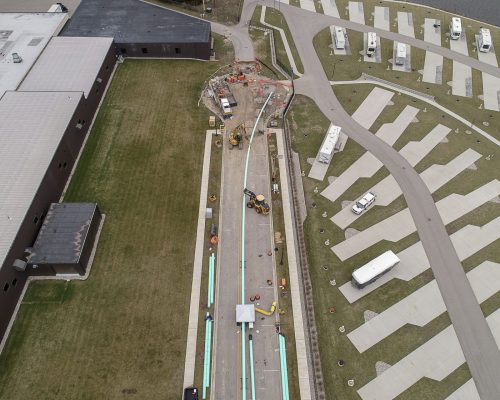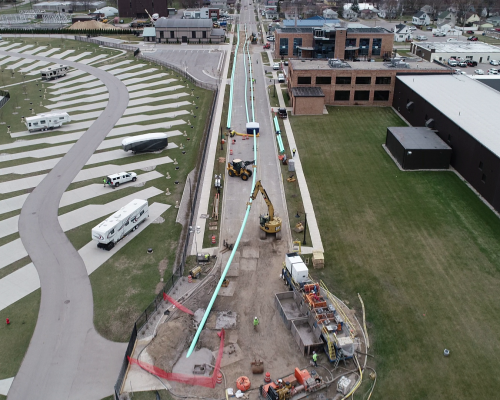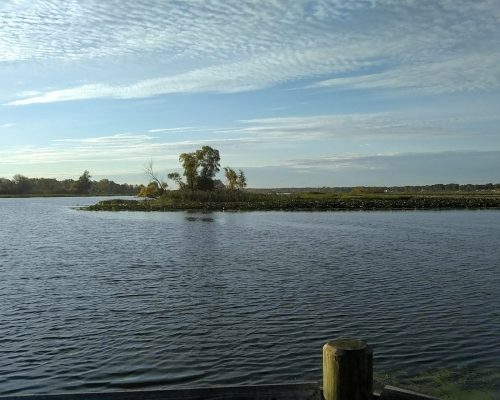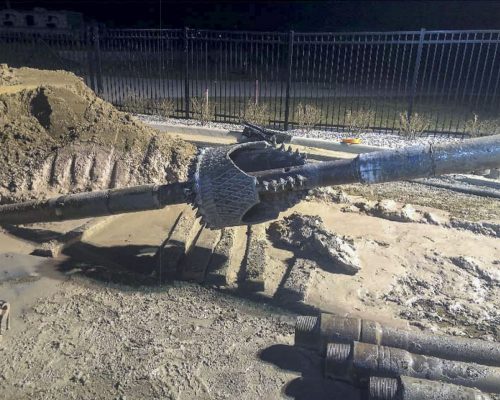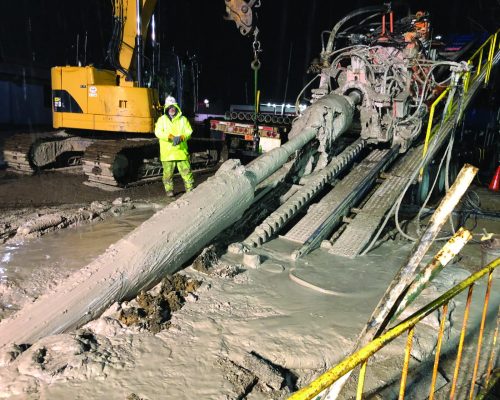A pipe that runs under the Grand River from the City of Ferrysburg, Spring Lake Township, and the Village of Spring Lake to the Grand Haven/Spring Lake Sewer Authority (GHSLSA) Wastewater Treatment Plant needed to be replaced. The pipe carries wastewater (3.5 Million Gallons a day) from Spring Lake Township to the treatment plant in Grand Haven. This pipe was originally installed in the 1972 via the open cut method. The ductile iron river crossing pipe was bedded in organic muck with only approximately 3 to 5 feet of river bottom on top of it. Over the last 45 years it has failed twice, once by a suspected anchor strike and the most recent one due to external pipe corrosion. Both breaks resulted in significant releases into the river.
In early 2017, Ottawa County Road Commission, acting as the financing agent for the Authority, and the GHSLSA developed a project that included upgrades and improvements to sewer lift stations in Spring Lake, Ferrysburg, and Grand Haven along with headworks upgrades at the treatment plant. The replacement of the force main from Spring Lake was also part of this project. The Road Commission hired Prein&Newhof to assess the condition of the existing force main in this critical location. In addition to reviewing options for rehabilitating or replacing the pipe, Prein&Newhof also analyzed the system’s existing capacity and determined what was needed to accommodate increased flow capacity due to growth in the region. The review determined the need for a new pipeline that not only could resist corrosion and be located deeper to protect against boating but also larger to provide more flow capacity.
The team compared trenchless methods with a barge-supported open cut approach and reviewed multiple pipe alignments and pipe materials. The project was reviewed with the Army Corps of Engineers and the Michigan Department of Environment Great Lakes and Energy to determine all known obstacles and concerns with the proposed project. Ultimately Horizontal Directional Drilling was determined to be the best approach. HDD could complete the installation without impacting navigation on the waterway and there was some concerns that endangered mollusks were present in this stretch of the river. HDD also allowed for a deeper pipe installation resulting in better protection of the pipeline. Prein&Newhof and the GHSLSA met with horizontal directional drilling (HDD) contractors during design to review feasibility of crossing the Grand River and limitations to the method, such as pipeline assembly and layout, drill staging, vibration, noise issues, access, and other impacts to local residents and businesses. All portions of the force main on land were determined to be installed via traditional open cut methods due to the tight working conditions, multiple turns in the alignment and presence of numerous other utilities.
Soil borings were completed in the river to depths of 120 ft. in order to understand the feasibility of the drill and to provide contractors information on how to approach the project. Soils were determined to be Very Soft Organic Silt and Marl in the river and extremely stiff clay on the shore at the bore entry and exit locations. The bore path was designed prior to receiving bids with the resultant path 90 ft below the bottom of the river in order to protect against hydrofracture. The length of the bore was designed to be 3,875 ft. from entry on the north side of the river to the exit on the south side of the river. The project was broken up into two contracts with the land portion and all connections being made by an excavating company and the crossing by a specialized HDD contractor. Pipe materials were selected based on numerous factors such as ease of maneuvering and assembly, tensile strength, inside diameter, and corrosion resistance. Fusible PVC was the selected pipe material due to its high pull strength compared to HDPE for the same wall thickness. This allowed for a thinner wall section to be selected and ultimately smaller bore hole with the Fusible PVC than would be allowed with HDPE. For the land based portion restrained joint ductile iron pipe was selected with poly wrap. Ductile Iron provided high strength and made it easier to work with in the tight conditions than a fused product.
Directional drill operations began on Cutler Street in the Village of Spring Lake. The team set up sound attenuation fencing to minimize disturbance to nearby residents and vibration monitoring equipment within the neighborhood to monitor impacts of the project to the surrounding structures. Drilling of the Pilot hole began on March 5 with completion of the pilot on March 19. Pipe reaming was begun immediately following the pilot hole and enlarged the 10” diameter pilot hole to 26 inches in diameter. Pipe pull back was started on April 10 following completion of the reaming and was completed within 13 hours. The pipe was “staged and pulled” from the south (Grand Haven) to the north (Spring Lake). Due to the limited amount of room for pipe staging the pipe was fused into six sections prior to the pull back. During Pull Back the pulling operation was paused intermittently to fuse each section together. The pipe was filled with water during the pullback operation to provide buoyancy control, the water helped lower the pullback forces by keeping the pipeline in the middle of the prepared hole.
Prior to completion of the pilot hole West Michigan Dirtworks, the excavating contractor, was installing the land based portion of the force main on the south side of the river and ultimately transferring the flow from the existing force main to the new forcemain. This work had to be completed prior to completion of the pilot hole due to the close proximity of the pilot hole exit to the existing pipeline. This also allowed for restoration of the roadway in front of an RV Resort prior to the start of the summer season. Following completion of the river crossing the land portion of the north side of the pipeline was completed and connected to the pump station. Flow was introduced into the new pipeline on June 6. The end result was a pipeline with a greater depth, eliminating the risk of boat or anchor strikes, a pipeline resistant to soil corrosion and an increased capacity from 3.5 MGD to 4.9 MGD.

